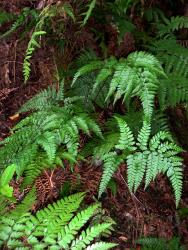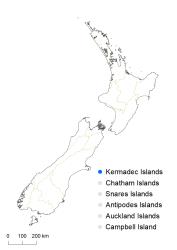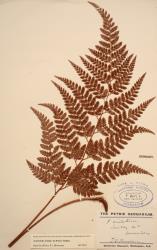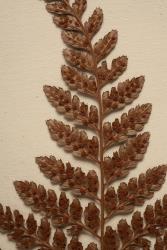- ≡ Polypodium aristatum G.Forst., Fl. Ins. Austr. 82 (1786)
- ≡ Aspidium aristatum (G.Forst.) Sw., J. Bot. (Schrader) 1800(2): 37 (1801)
- ≡ Nephrodium aristatum (G.Forst.) C.Presl, Reliq. Haenk. 1, 37 (1825)
- ≡ Polystichum aristatum (G.Forst.) C.Presl, Tent. Pterid. 83 (1836)
- ≡ Lastrea aristata (G.Forst.) T.Moore, Index Fil. 86 (1858)
- ≡ Dryopteris aristata (G.Forst.) Kuntze, Revis. Gen. Pl. 2, 813 (1891)
- ≡ Rumohra aristata (G.Forst.) Ching, Sinensia 5: 50 (1934)
- ≡ Polystichopsis aristata (G.Forst.) Holttum, Rev. Fl. Malaya 2, 486 (1955)
- ≡ Byrsopteris aristata (G.Forst.) C.V.Morton, Amer. Fern J. 50: 152, t. 14 (1960)
Rhizomes long-creeping, up to 70 mm long (in herbarium material), 5–10 mm diameter, densely scaly. Rhizome scales narrowly ovate, 3–9 mm long, 0.4–0.8 mm wide, red-brown, concolorous, margins entire. Fronds 680–1050 mm long. Stipes 320–650 mm long, pale or chestnut-brown, scaly, especially near junction with rhizome; scales linear, pale brown, up to 15 mm long, 1 mm wide. Rachises pale brown, sulcate, narrowly winged distally, scaly; scales scattered throughout, linear, pale brown, up to 4 mm long and 0.2 mm wide. Laminae 3–4-pinnate at base, ovate or broadly ovate or 5-angled, 240–430 mm long, 190–460 mm wide, dark shining green adaxially, paler green abaxially, coriaceous, bearing linear scales on abaxial costae, almost glabrous adaxially. Primary pinnae in 16–24 pairs below pinnatifid apex, widely spaced especially proximally, narrowly ovate distally, ovate or broadly ovate proximally; the longest at the base, 145–320 mm long, 68–225 mm wide, apices acuminate, bases stalked, costae narrowly winged for most of their length. Acroscopic secondary pinnae decreasing evenly in length along the primary pinna to the distal end; the basal basiscopic secondary pinna the longest, ovate, 43–195 mm long, 18–48 mm wide, apices acute, bases stalked, costae winged throughout. Tertiary pinnae ovate or oblong, 12–40 mm long, 6–15 mm wide, apices acute, bases stalked, costae winged throughout. Ultimate lamina segments up to 12 mm long and 5 mm wide, apices acute, margins sharply toothed, bases stalked. Sori round, nearer costa than margin; indusia reniform, 0.8–1.5 mm diameter, with dark centres, glabrous.
Arachniodes aristata is recognised by its terrestrial habit, long-creeping rhizomes, 3–4-pinnate laminae with sharply toothed margins, scaly fronds, and round sori protected by reniform indusia.
Kermadec Islands
Altitudinal range: 60–440 m.
In New Zealand Arachniodes aristata is known only from Raoul Island, where it is common in dry forest areas under Rhopalostylis baueri and Metrosideros kermadecensis.
Three sheets of material, said to be from the Chatham Islands, are held at WELT. Two were collected by Travers (WELT P003394, P003683), and the other is from the Kirk Herbarium. The species was not listed by Mueller (1864) from the specimens collected by Travers in 1863, nor by Cheeseman (1906, 1925), Allan (1961), or de Lange et al. (2011). The species is not known on the Chatham Islands today, and the status of the three collections in WELT is unclear.
Also Australia (Queensland, New South Wales), Lord Howe Island, Norfolk Island, and most South Pacific islands from Solomon Islands to Pitcairn Island.
Arachniodes aristata was reported to be the commonest terrestrial fern of dry forest areas on Raoul Island, but absent from wet forest and swamp (Sykes 1977). It has been collected from roadsides and damp banks.
Arachniodes aristata was given a conservation status of Naturally Uncommon by de de Lange et al. (2018).
2n = 164 (de Lange et al. 2004). This is the same tetraploid number as that reported by Brownlie (in Fabbri 1963) for the species in New Caledonia, but different to the diploid count of n = 41 reported in Australia (Tindale & Roy 2002).
Fraser-Jenkins et al. (2018) noted that “Although the name has long been applied to various Indian and Asian species … the true A. aristata from Tahiti etc. is a different species with smaller, stiffer segments and a less markedly longer lowest basiscopic pinnule of the lowest pinna. The reports from India, Bhutan and mainland Asia, and also from South Africa, refer to other species …”. This observation has been confirmed by Lu et al. (2019), who found the two groups to be resolved in different clades.







